
Rediscovering Japan

Rediscovering Japan
Travel (Hiroshima Prefecture (Miyoshi/Shoubara))

by tomizuta
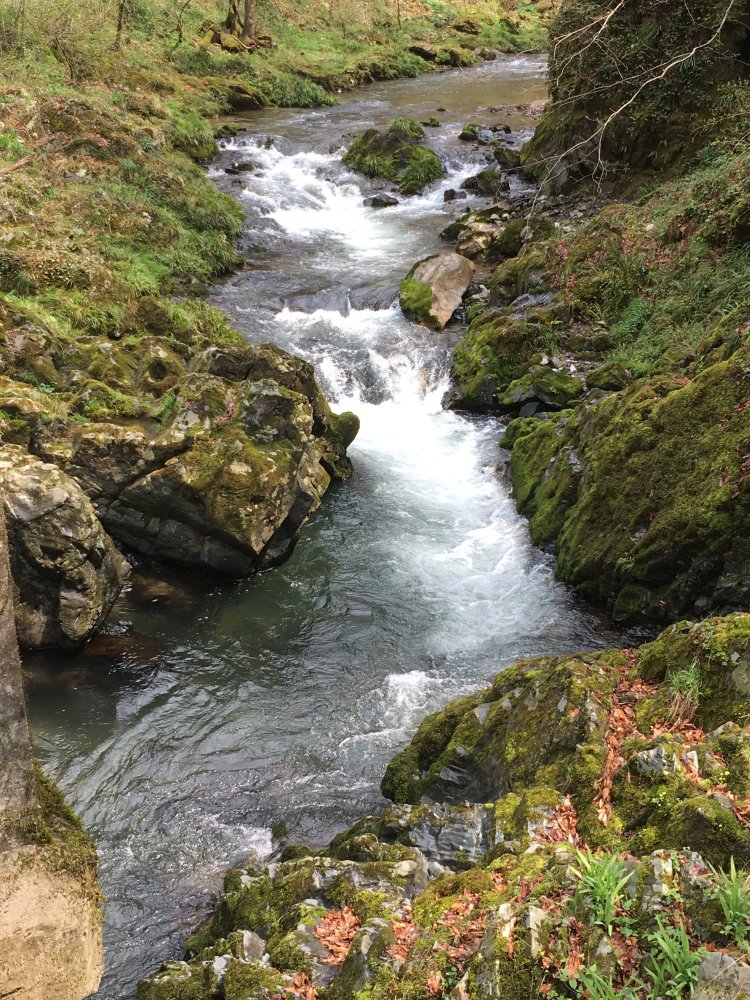
The upstream of Taishaku River in Taishakukyou was serene and beautiful.
Taking advantage of my semi-annual trips to Hiroshima Prefecture to visit relatives, I continue to visit the areas I have never been. In early April 2018, I planned to visit two picturesque valleys in the prefecture, Sandankyou and Taishakkyou. We left our relatives at about three o’clock in the afternoon to head approximately forty kilometers north into the Chugoku Mountains. Accommodation around Sandankyou is quite modest so we opted to stay at a hotel further north west in the Geihoku area. By the time we were approaching the hotel it started to snow quite heavily and driving was treacherous with normal tires. We finally got to the hotel and were greeted by the staff who told us that this heavy snow in April was quite unexpected for them as well. We were concerned that we would be stranded at the hotel if the weather did not improve. The following morning, the snow had become lighter but we had to give up visiting Sandankyou and decided instead to spend more time in Miyoshi City at a much lower elevation of 200 meters above sea level on our way east to Taishakkyou also in the Chugoku Mountains.
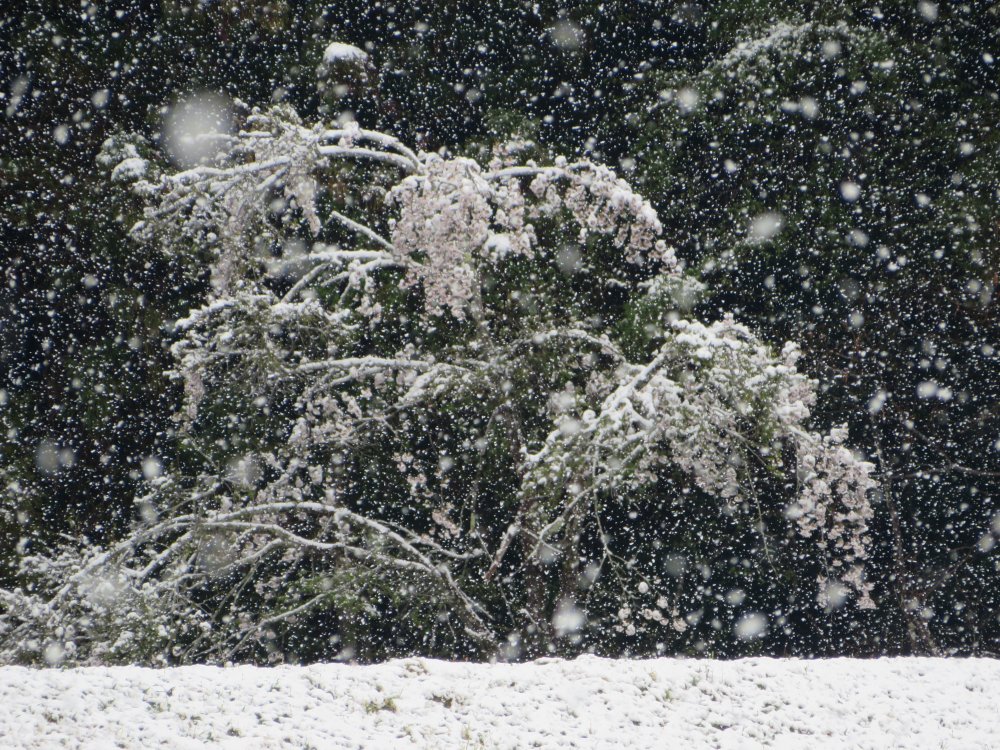
The cherry blossoms at full bloom were freezing in the heavy snow.
It was still snowing from time to time as we climbed down the Chugoku Mountains. In the lower altitude area the cherry blooms in full bloom appeared to be freezing in the snow.
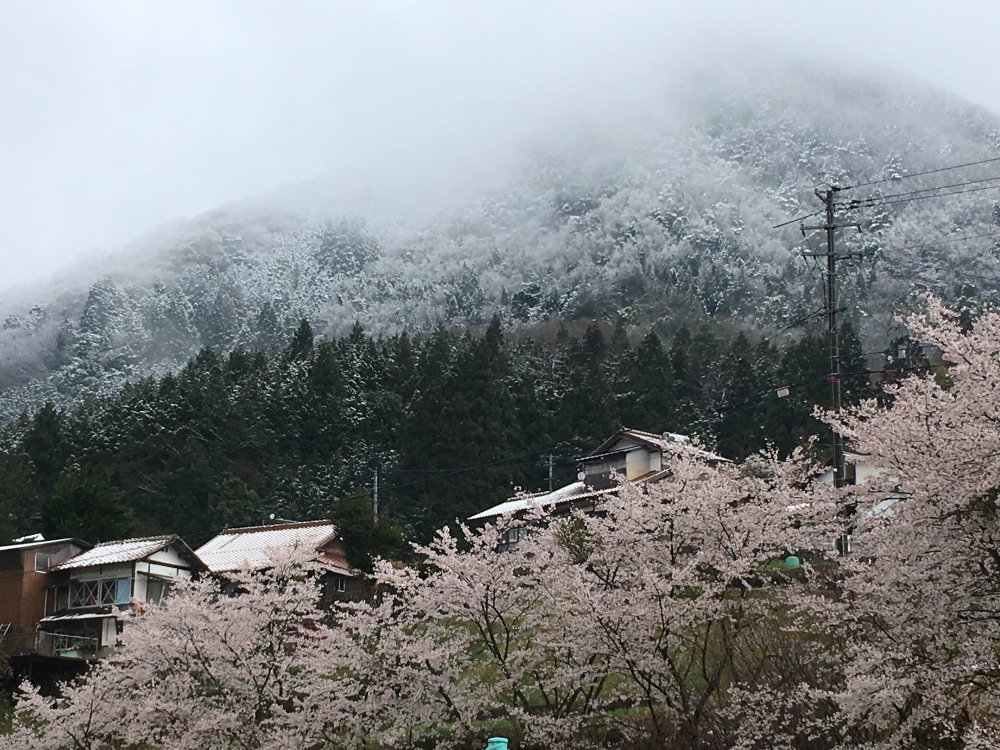
This contrast of cherry blossoms at full bloom and snow is very rare. April 2018 in Kitahiroshima City.
Here I need to talk a bit about Hiroshima’s history in the feudal era. Hiroshima was long ruled by the powerful Mouri Family. Upon defeat of the Western Army of which Mouri was the leader, the Mouris lost a large part of its domain including Hiroshima. Masanori Fukushima, who was a subordinate of HideyoshiToyotomi and later Ieyasu Tokugawa, became the feudal lord in 1600 until he was relocated to northern Nagano. Following Masanori’s departure, Nariakira Asano became the feudal lord of Hiroshima and the Asano Family’s rule continued until 1871 following the Meiji Restoration. In 1632 Nariakira Asano gave his son Nagaharu Asano the Miyoshi area to rule as a sub feudal domain. Miyoshi feudal domain lasted till 1720 when the fifth Miyoshi Asano lord died with no heir.
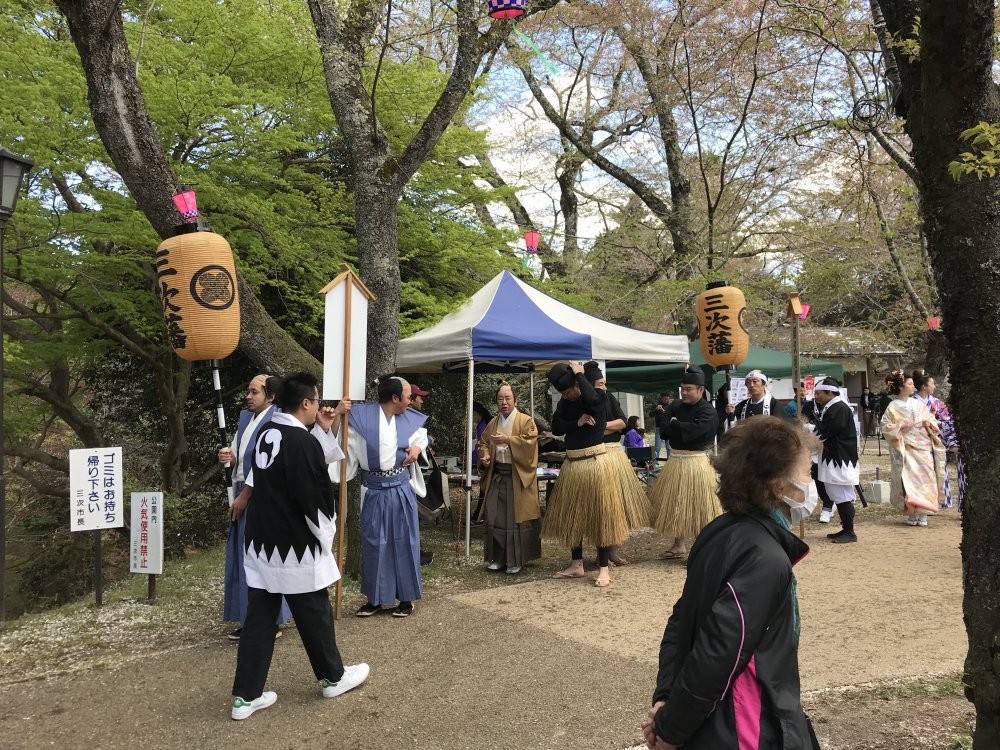
The lantern like object shows the emblem of the Miyoshi Asano Family.
The Sakura Festival was being held the day we visited Miyoshi City. The event was at Ozekiyama Park where Ozekiyama Castle once stood on a hilltop. Ozekiyama was named after MasakatsuOzeki, a subordinate of Masanori Fukushima that resided in the castle. In the Miyoshi sub feudal domain period the castle served as a second residence for the Miyoshi Asano family. A costume parade was just about to start. The star was Princess Aguri. She was the tragic princess of the Miyoshi Asano family that married Takuminokami Asano, the feudal lord of Akou feudal domain in Hyogo Prefecture. Her husband attacked Kouzukenosuke Kira, another feudal lord in Edo Castle in 1701. Takuminokami Asano was ordered to kill himself on the day and the Akou feudal domain was discontinued. Forty seven samurais angry at the harsh treatment, revenged by assassinating Kouzukenosuke Kira, after which they were sentenced to commit suicide.This became the famous kabuki theme KanatehonChuusingura. Princess Aguri became a Buddhist nun and was taken care of at the Edo residence of the Miyoshi Asano Family.
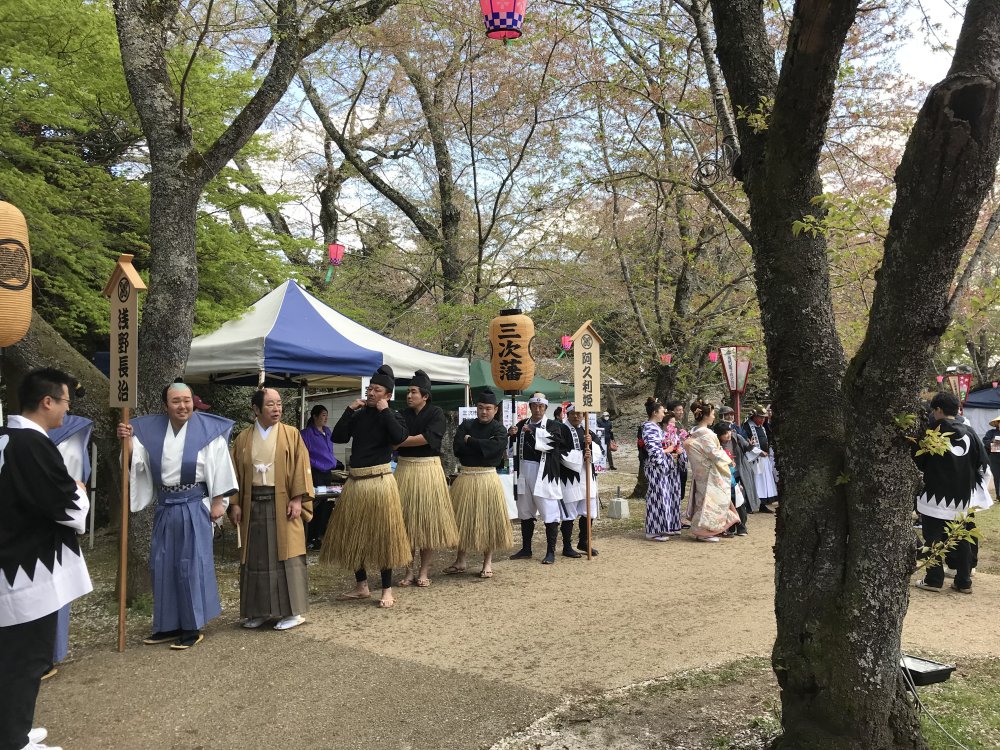
The costume parade was just about to start. The first lord Nagaharu in front and his daughter Princess Aguri in the far back
We then went to visit Jusaburou Tsujimura Museum. This is a museum in a
former bank building displaying the dolls and puppets of Jusaburou Tsujimura,
the master doll maker and puppeteer. Jusaburou spent his boyhood in Miyoshi
I knew of his puppetry through a TV show, but never had fully appreciated
how real life and deftly created his dolls were.
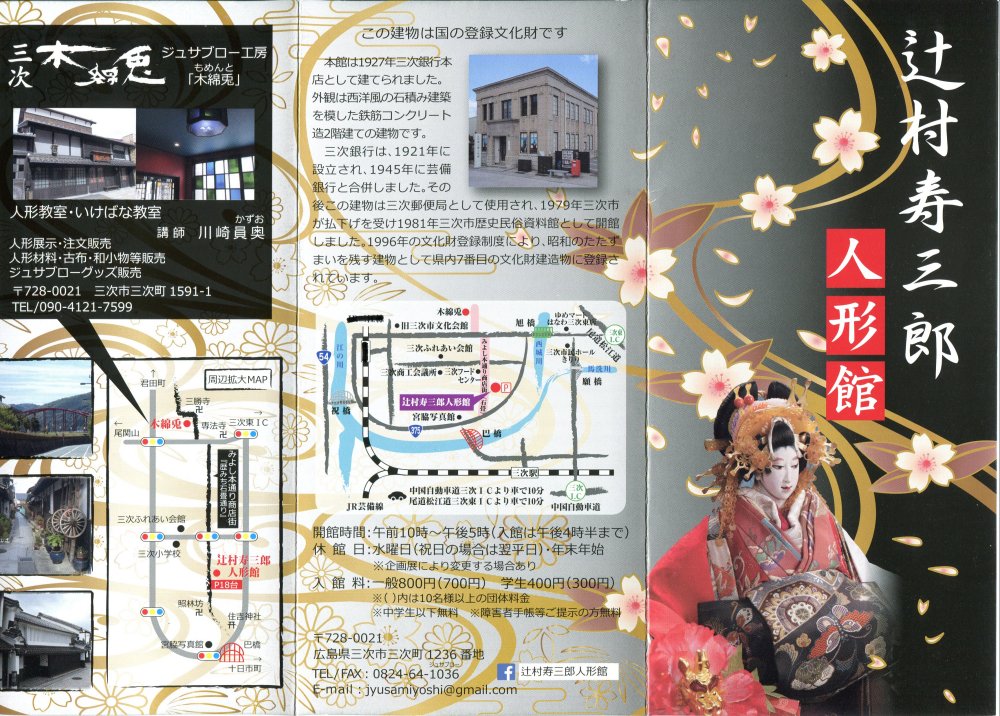
Pamphlet of the Jusaburo Tsujimura Doll Museum. There's a studio and art class further up high street.
The museum is on Hondoori, which is the high street of Miyoshi City stretching north south for about half a mile. Many Edo/Meiji style merchant buildings with udatsu (fire spreading prevention walls) have been preserved on both sides of the roads.
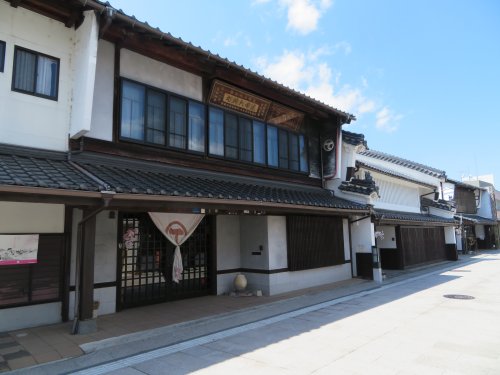
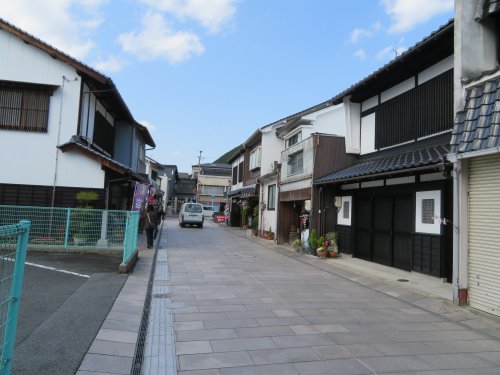
Many Edo/Meiji style merchant buildings with udatsu (fire spreading prevention walls) have been preserved on both sides of Miyoshi Hondoori.
Our final place to visit in the city center was Hougenji, a Buddhist temple of the Rinzaishuu zen sect, where the Miyoshi Asano Family’s graves are situated. A volunteer guide offered to give us a quick tour. We went up the steep steps to come to the grave area. The guide introduced a wooden shrine of the forty seven samurais that achieved revenge. We were told that there was a pagoda dedicated to Princess Aguri further up.
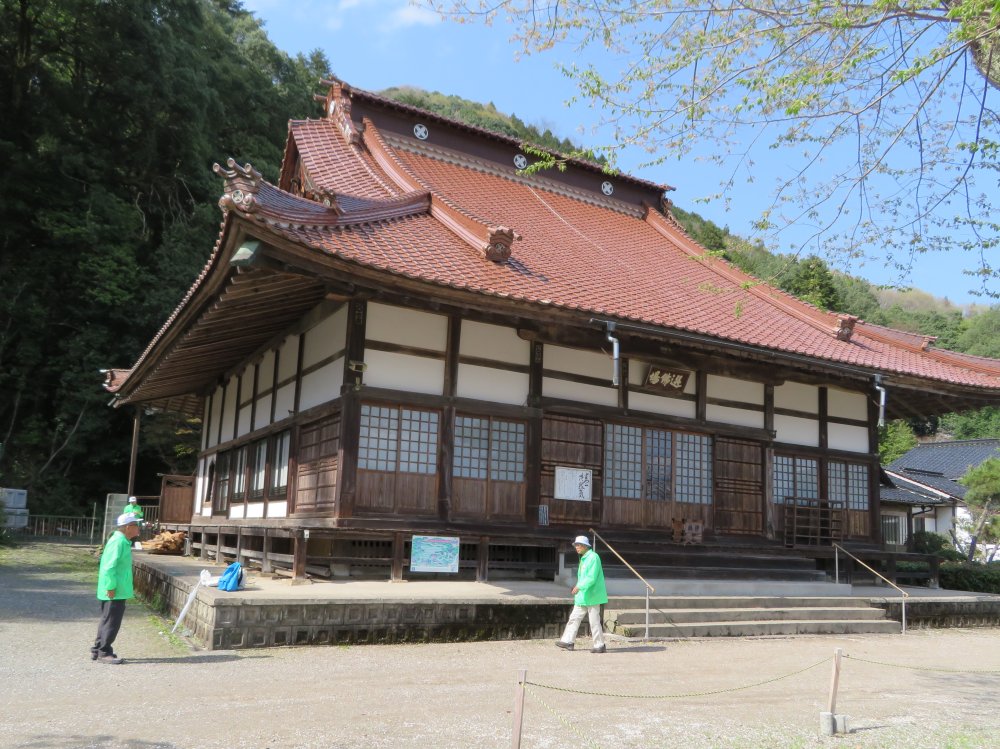
At Hougenji Temple a volunteer guide offered to give us a quick tour.
We left the city center to visit Hiroshima Prefectural History Museum about seven kilometers east. I learned with interest that our ancestors settled early in the valleys and plateaus of central Hiroshima Prefecture no doubt because of the water and good hunting and fishing places. Many early settlements as well as large graves (kofuns) dating up to the establishment of the Yamato Court in the sixth to seventh century. This was similar to the Suwa and Chino area in Nagano Prefecture also surrounded by lakes and mountains. Outside the museum, there are some replicas of early settlement huts and coffins excavated elsewhere and relocated to this site.
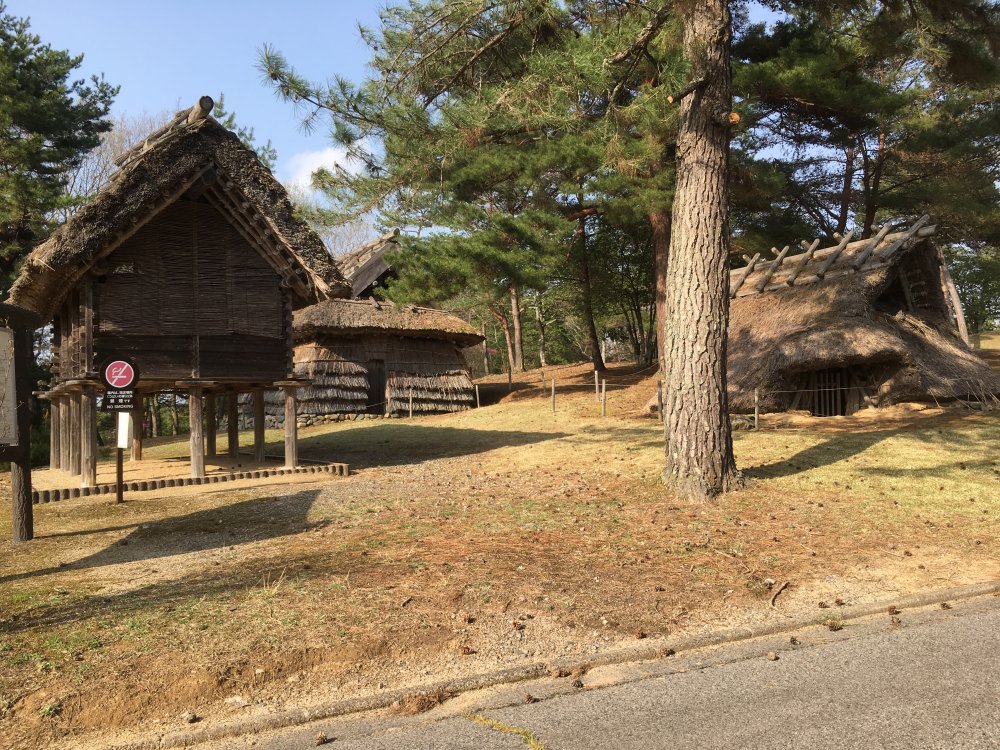
Outside the museum, there are some replicas of early settlement huts.
We left our hotel in Taishakukyou to take the boat cruise of the valley. Japan National Tourism Organization (JNTO) introduces Taishakukyou as “a 15-kilometer-long canyon in the Kibi-kogen Highlands in eastern Hiroshima that was carved into the karst tableland by the Taishaku-gawa River. It has magnificent scenery with a wide variety of features, including precipitous cliffs, caves, mountain streams, depths, torrents, and waterfalls”. https://www.jnto.go.jp/eng/spot/natuscen/taishakukyo.html
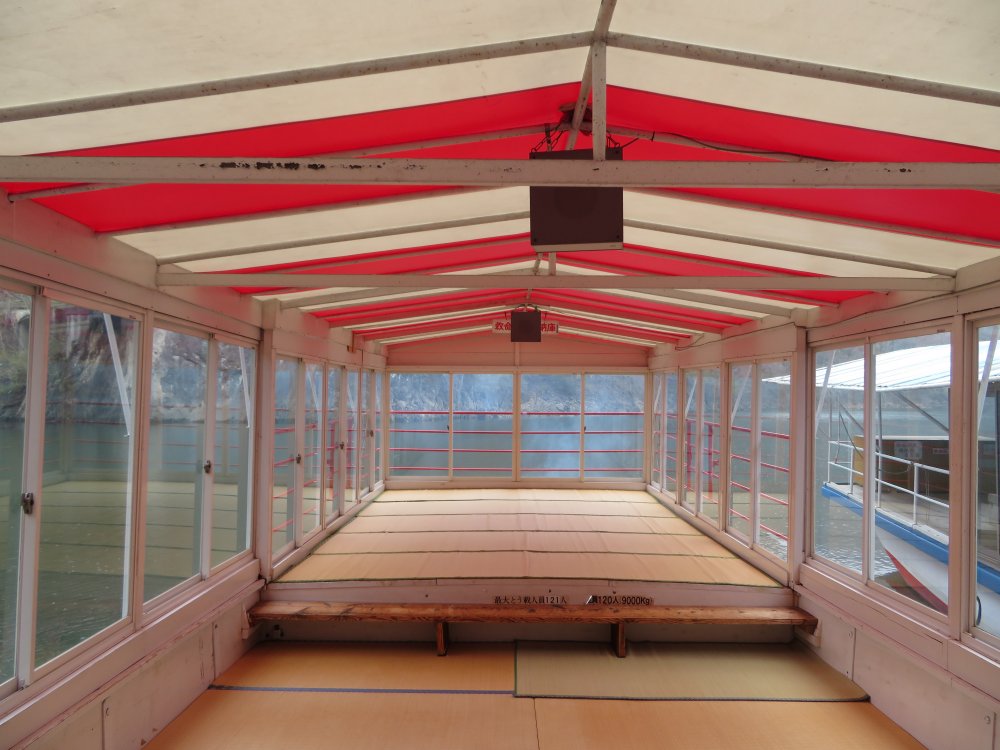
We had this big boat to ourselves as it was before the tourism season.
The boat cruise starts every thirty minutes from 9:00 to 16:30. We went to the ticket office at 9:00 but were advised that the first cruise would leave 9:30 and asked to wait in the waiting room. No wonder why, as when we were taken to the boat with a seating capacity of a hundred twenty us two were the only passengers. The tourism season doesn’t start here till late April. The boat cruise took us upstream first, made a U-turn past the starting point downstream to the end of the dam. This Lake Shinnryuu is a serpent like dam built over Taishaku River, which flows south to join Takahashi River in Okayama Prefecture and flows into the Seto Inland Sea. The cruise takes forty minutes and gives you the chance to really appreciate the beauty of this valley. The cruise ticket is 1,200 yen per person, but in most cases you should be eligible for a discounted price of 1,000 yen by using a discount voucher that most hotels provide to guests.
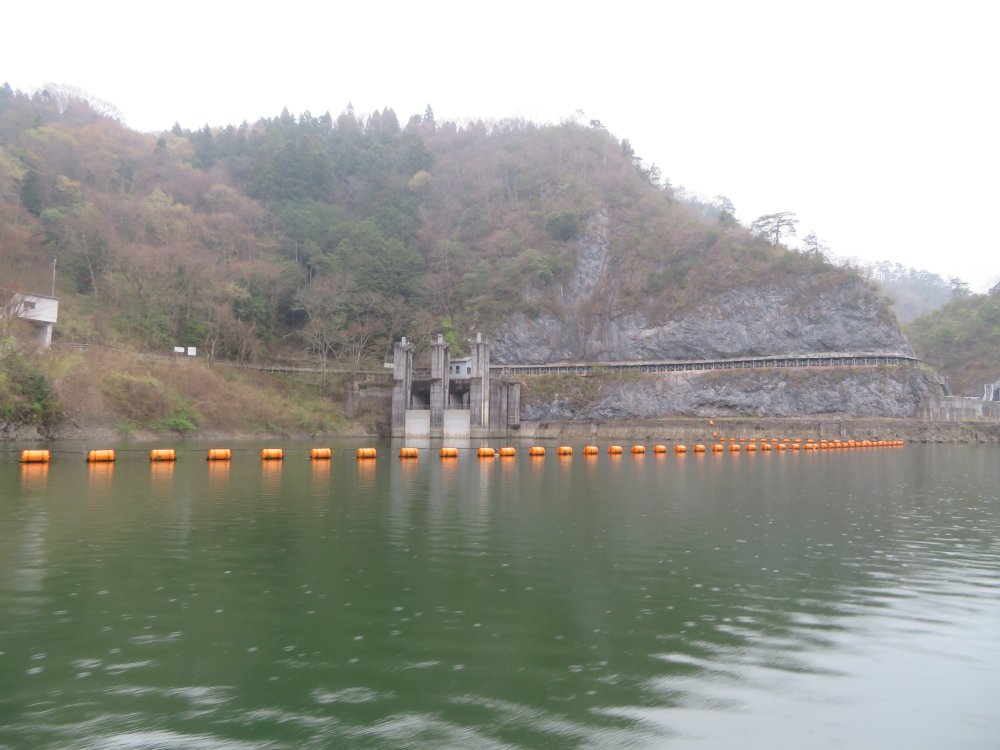
This Lake Shinnryuu is a serpent like dam built over Taishaku River.
We then drove about fifteen kilometers to the car park at the northern end of Taishakukyou. It is a forty minutes’ walk along the river to reach Onbashi Bridge. JNTO says “The highlight of the Taishaku Valley is On-bashi Bridge, a 90-meter-long, 19-meter-wide and 40-meter-high natural limestone bridge. The bridge, regarded as one of the three largest natural bridges in the world, has also been designated as a nation’s natural monument”. On the way to Onbashi Bridge is a limestone cave called Hakuundou. You can go inside for about two hundred meters. Contrary to large caverns most of the route is a very narrow path that you can just squeeze through. It is quite an intriguing sight worth the two hundred yen admission fee.
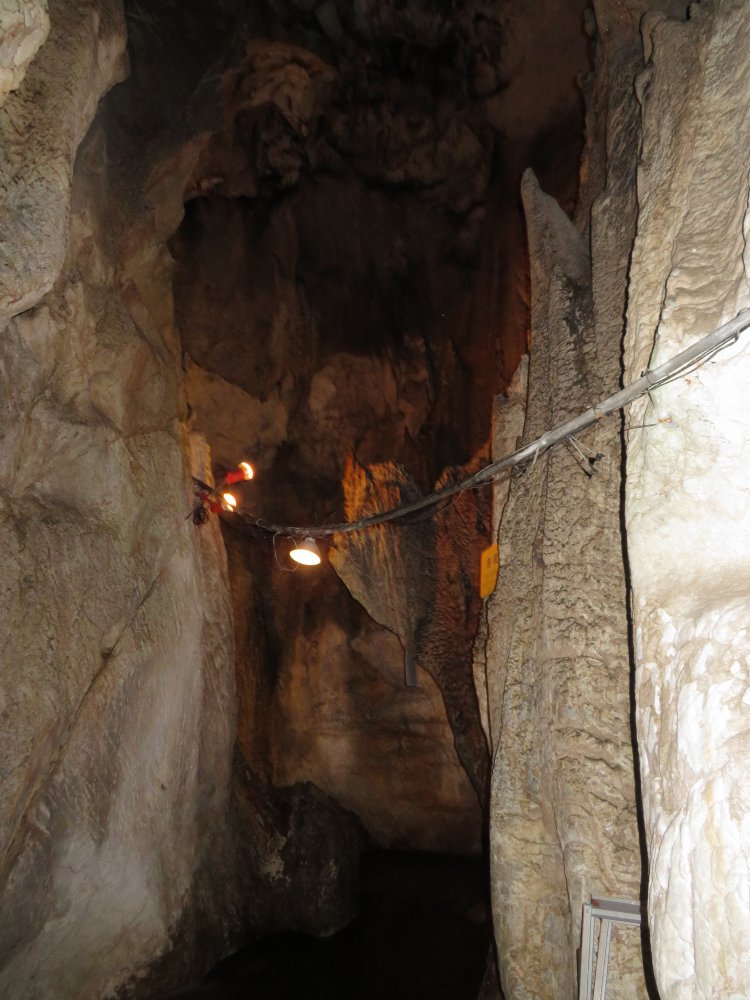
Contrary to large caverns most of the route is a very narrow path that you can just squeeze through.
The walk along the river to the bridge is really enjoyable. The area is so beautiful that we were tempted to take pictures every now and then. I also understand that the valley is a sanctuary for rare insects as well as the Japanese salamander.
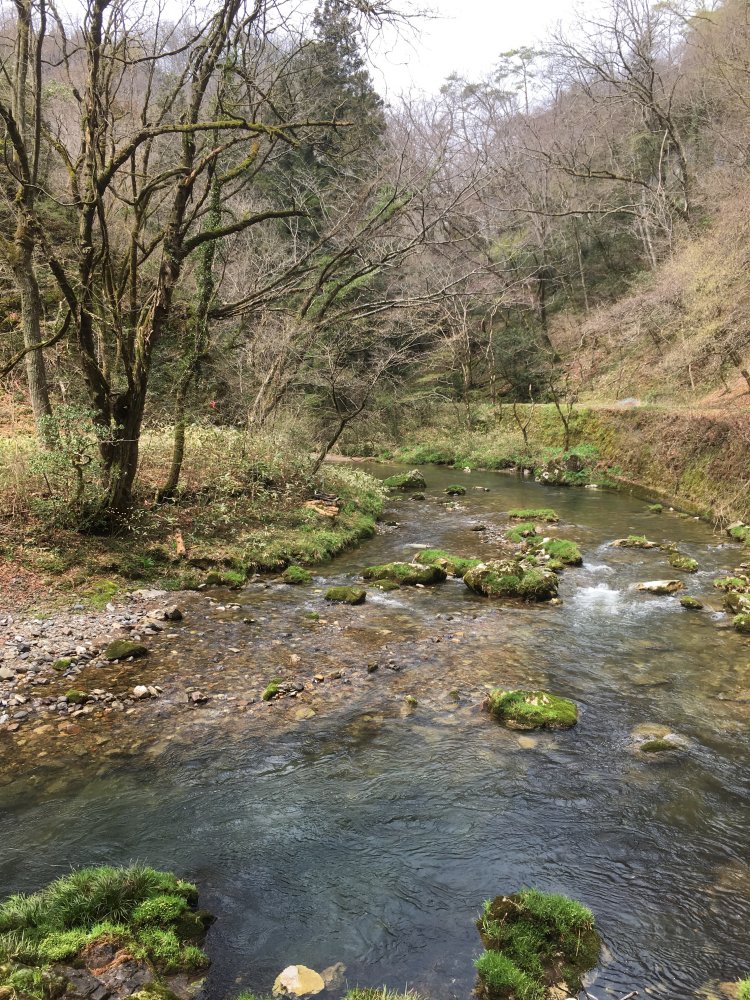
The walk along the river to the bridge is really enjoyable. The area is so beautiful that we were tempted to take pictures every now and then.
We finally reached Onbashi Bridge. It’s really difficult to get a feel of the gigantic size of this natural bridge over the river, looking up from the river bank below. I understand in the old days travelers crossed over this natural bridge to make their way to their next destinations.
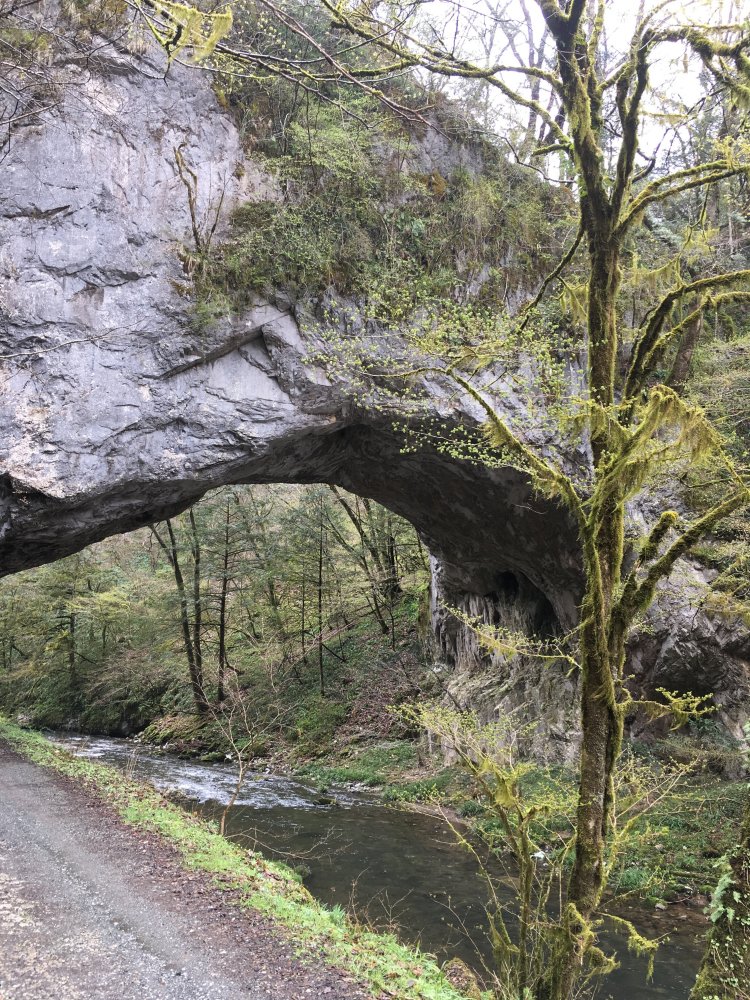
It’s really difficult to get a feel of the gigantic size of this natural bridge over the river, looking up from the river bank below.
The northern area of Taishakukyou is part of Tojo (east castle) Town in Shoubara City. There is a Saijo (west castle) Town about thirty kilometers west also in Shoubara City. I understand that these castles that no longer exist were the defense castles of a pre -Edo era feudal lord, the Miyoshi Family. The last place to visit was Kumano Shinto Shrine in Saijo Town. This Shrine that worships Goddess Izanami was founded here as a praying spot to Goddess Izanami’s burial place in Mount Hiba (according to one of Japan’s oldest chronicles Kojiki composed in the 8th century) further up in the Chugoku Mountains. We went up the steps to come to a plateau surrounded by huge pine trees that must be several hundred years old at least. The path leading further up reminded me of the pilgrimage routes in the Kii Mountains.
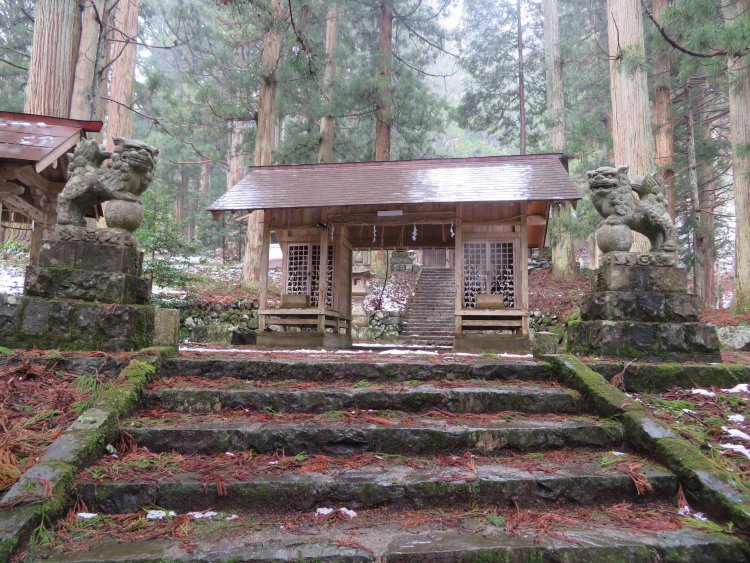
We went past the two guardian lion dogs that you often see in Shinto shrines, through the grand entrance gate and then further up to the main shrine.
We went past the two guardian lion dogs that you often see in Shinto shrines, through the grand entrance gate and then further up to the main shrine. The shrine is not grand as for instance Ise Jinguu or Izumo Taisha, but still quite impressive in this serene setting.
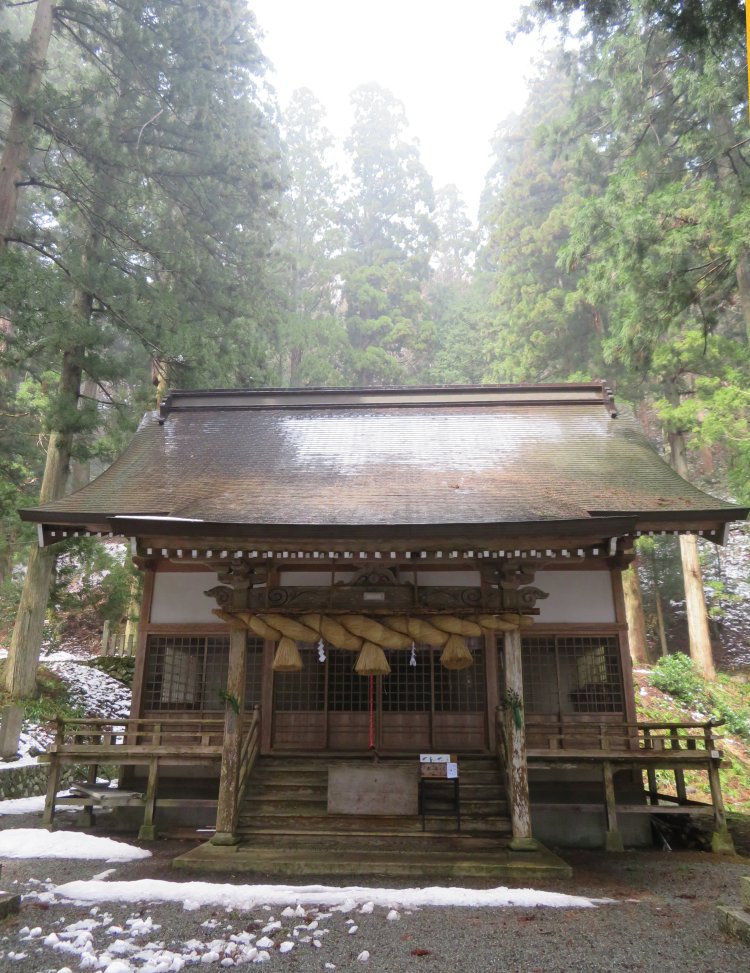
The foxes are everywhere
On our way back to Hiroshima Airport, I didn’t forget to purchase local sake. On this occasion I bought a 720 milliliterbottle of Kikubunmei honjouzou brewed in Tojo Town.
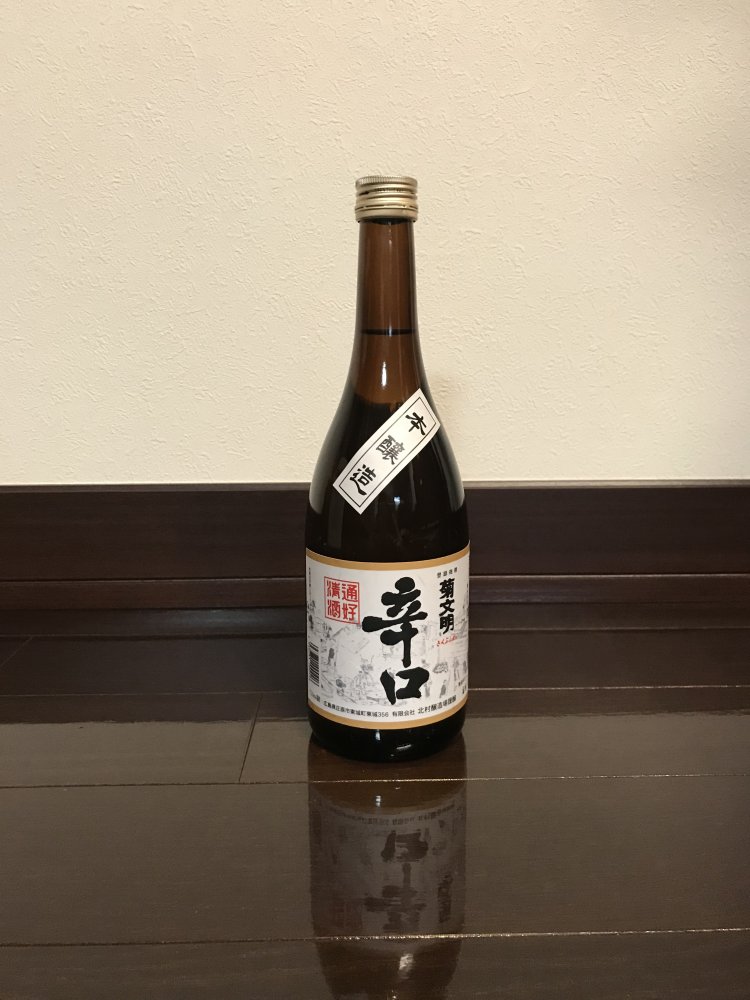
I bought a 720 milliliter bottle of Kikubunmei honjouzou.